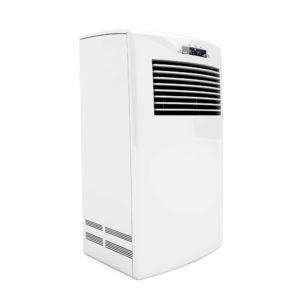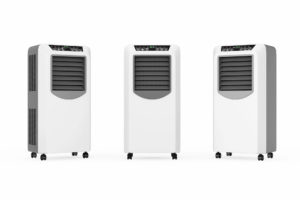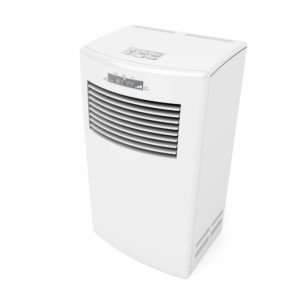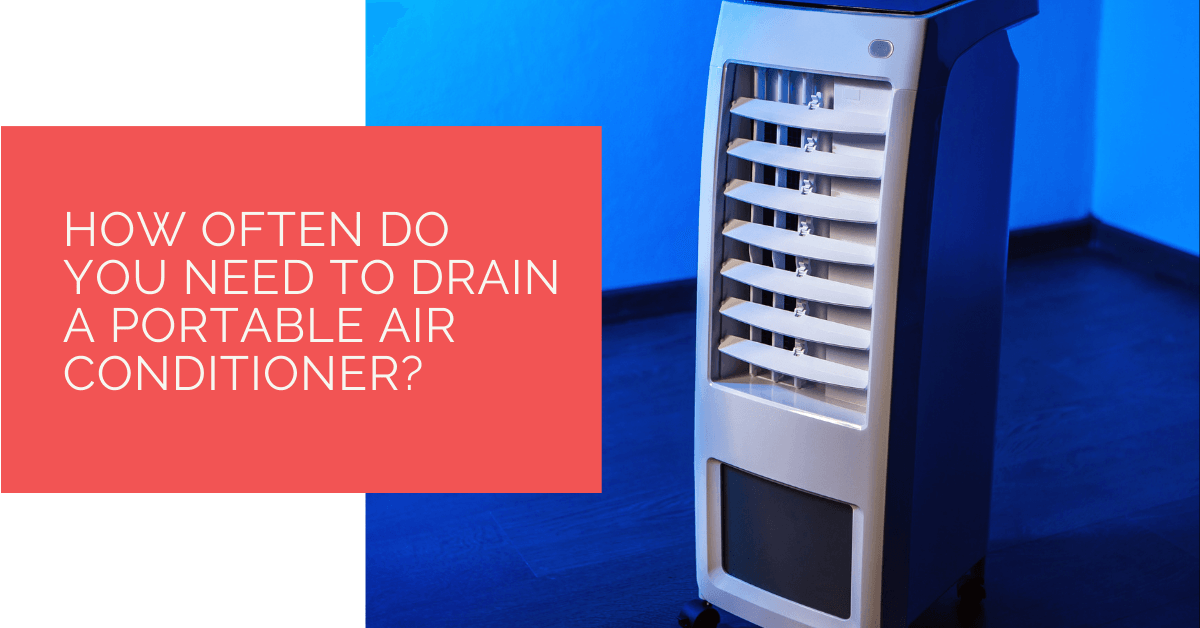To perform correctly, portable air conditioners require routine maintenance. Draining the condensate tank is one of them.
The indoor air quality determines the frequency at which you should empty your portable air conditioner.
To understand this better let’s look at some factors that determine how frequently one should drain them.
Contents
- 1 Key Takeaways
- 2 When to drain a portable air conditioner?
- 3 How to drain your portable AC unit?
- 4 How long can you run a portable air conditioner continuously?
- 5 Why is your portable air conditioner producing so much water?
- 6 Setting up a continuous drain system
- 7 Do all portable ACs need to be drained?
- 8 Heat Pump Source: Reliable Heating and Cooling Solutions
- 9 Final thoughts
Key Takeaways
- The frequency of draining a portable air conditioner depends on indoor humidity, with some units needing drainage every 8 hours in humid conditions.
- Draining your portable AC involves simple steps like unplugging it, using a pan or hose for drainage, and considering a continuous drain system if available.
- Running a portable air conditioner continuously is fine, but occasional breaks are advisable for cooling, component protection, and longevity, and excess water production may be due to factors like dirty filters or low refrigerant levels.
When to drain a portable air conditioner?
You may need to drain your portable air conditioner as frequently as every 8 hours, depending on the humidity of your room. But if you live in a dry climate, you won’t have to drain very often.
 This is because the water used to fill your portable air conditioner comes from cooling warm, humid air. If the air in your environment is dry, the air conditioner will not extract any moisture.
This is because the water used to fill your portable air conditioner comes from cooling warm, humid air. If the air in your environment is dry, the air conditioner will not extract any moisture.
The exhaust vent on most new portable air conditioners can eliminate moisture from your property. It does this by spraying water from its condensate tank onto the condenser coil.
The condensate evaporates as it comes into touch with the heated condenser coil and the vapour is subsequently expelled from your home via the exhaust line.
Most of the time, this procedure works to remove the water from the condensate tank of your portable air conditioner, and it is only in humid conditions when you need to empty it frequently.
How to drain your portable AC unit?
People who have central AC should know how to monitor the Freon level in their systems while those who use window air conditioners, must have a clean space surrounding their unit.
In the case of the portable unit, one must know when to remove the extra water from their equipment. Although it may appear complicated, most machines offer simple access to an internal water tank, allowing owners to readily remove any accumulated water vapour.
To do this, one must follow the following steps:
- Remove your machine from the power outlet and unplug it.
- If you’re using a pan, put it beneath the drain port, which is generally near the rear of the machine. Drain into the pan after removing the drain stopper. Return the drain plug to the unit after removing the collected moisture in the external water tray and wiping up any spills with the towel.
- On the other hand, if you’re using a hose, remove the drain plug and attach the hose with waterproof attachments. Drain the water out, remove the hose and reconnect the plug to the machine after drying any spills.
- Check your unit’s manual to see whether an aftermarket continuous drain hose is suitable. Water is routed from the reservoir through the aftermarket drain pipe and into the place of your choice in a continuous drainage system, eliminating the need to manually drain the unit. Also, keep an eye out for indicators of a clogged drain and call a repair service if it’s broken.
How long can you run a portable air conditioner continuously?
One shouldn’t have any problems running their portable AC continually. You can run your air conditioner all season long if you clean the air filters and empty the condensate tank.
 However, this does not imply that you should leave your air conditioner on all of the time. It’s a good idea to give your portable AC breaks like any other mechanical equipment. Turning it off allows it to cool down, prevents damage to its components, and ensures longevity and smooth functioning.
However, this does not imply that you should leave your air conditioner on all of the time. It’s a good idea to give your portable AC breaks like any other mechanical equipment. Turning it off allows it to cool down, prevents damage to its components, and ensures longevity and smooth functioning.
Regardless of whether or not you turn your air conditioner off, it should switch off on its own after cooling a room. As your room cools down to the temperature setpoint, an adequately large air conditioner will operate in 10–20-minute intervals.
If your portable air conditioner is always running, it’s probably too small for the space. There might be additional sources of heat or moisture in the area that need to be separated. You can absorb the humidity in a room in many ways to help with this.
Why is your portable air conditioner producing so much water?
If your air conditioner is producing more water, it might be because of one of the following reasons:
Dirty air filters
When your portable air conditioner’s air filter is dirty, partially blocked, or entirely clogged, the evaporator coils of your AC are more prone to freeze, causing extra water to overflow from the drain pan.
Broken condensate pan
Your condensate pan may rust, damage, or split over time, allowing water to drain from your air conditioner, depending on the age of your unit.
Drain pipe blockage
The water from your air conditioner flows to the drain pan through a complicated series of drain pipes. If the drain line is clogged, chances are water might flow from your conditioning unit.
Improper installation
If your air conditioner is new and is leaking a lot of water, it’s most likely due to a problem with the installation. So, look for improperly sized or faulty drain tanks.
Chilly temperatures
After the air conditioning season, if the temperature outdoors is cooler, your AC may leak.
When the outside temperature is below 15 degrees, your unit tries to cool your home which leads to the freezing of the coils which causes leakage.
Low refrigerant levels
If your refrigerant levels are low, your AC system’s pressure will drop causing the evaporator coils to freeze up again. This will lead to your drain overflowing.
Setting up a continuous drain system
 The good news is that most portable air conditioners enable the installation of a continuous drain setup that drains the water, eliminating the need for any manual emptying.
The good news is that most portable air conditioners enable the installation of a continuous drain setup that drains the water, eliminating the need for any manual emptying.
To set up continuous (gravity) drainage, ensure the following:
- Empty the water collected in the unit’s water reservoir first (see the handbook for details).
- In rare circumstances, an ordinary garden hose can also be used in place of a drain hose. Measure your drain port aperture and purchase a hose with the necessary width (or thread type) to fasten it to your unit’s drainage port.
- Determine an optimal drainage site for the drain line and be sure to position the hose as straight as you can. Also, make sure the hose points downward, as gravity helps with drainage.
Do all portable ACs need to be drained?
Newer units of portable air conditioner units don’t always need manual draining. EdgeStar, Avallon, and Koldfront units use a condensation exhaust system to evacuate any water vapor gathered during the cooling or dehumidifying process.
The moisture is subsequently expelled with hot air through the system’s exhaust hose.
However, you may need to turn off your air conditioner in rare situations. When there is excess humidity, the water gathered during the cooling process isn’t rapidly drained enough and water may get filled in the internal reservoir.
Heat Pump Source: Reliable Heating and Cooling Solutions
At Heat Pump Source, we take pride in our unwavering commitment to serving the UK with top-tier HVAC solutions. From the efficiency of heat pumps and the cool relief of air conditioning to the warmth of boilers, radiators, and underfloor heating, our dedicated team is always at the forefront of innovation. We understand the unique needs of every household and business, and we strive to provide dependable health and cooling products and services that are tailored just for you. Ensuring your comfort and satisfaction is our utmost priority. Whether you have questions, need guidance, or require support, we’re always here to assist. Please don’t hesitate to contact us; we’re eager to be of service.
Final thoughts
Portable ACS require the least maintenance. All you need to do is ensure that the produced water is drained correctly every few hours, especially in more humid climates.
The newer versions do not require the water tank to be emptied frequently but for the older versions, we recommend you check your manual.
About the Author
At Heat Pump Source, our articles are the product of a collaborative effort among a team of highly skilled HVAC experts. Our dedicated professionals, hailing from diverse backgrounds in heating, ventilation, air conditioning, and refrigeration, contribute their extensive knowledge and experience to every piece of content. This multidisciplinary approach ensures comprehensive coverage. Our commitment is to deliver authoritative, reliable, and tailored advice to meet the unique needs of every household and business across the UK.

